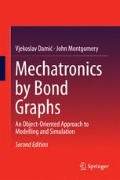Abstract
There is an extremely large body of literature dealing with the modelling and simulation of multibody systems, e.g. (Wittenburg in Dynamics of systems of rigid bodies. BG Teubner, Stuttgart, 1977; Haug in Computer-aided kinematics and dynamics of mechanical systems. Allyn and Bacon, Boston, 1989; Schiehlen in Multibody systems handbook. Springer-Verlag, Berlin, 1990; von Schwerin in Multibody system simulation: numerical methods, algorithms, and software. Springer, Berlin, 1991; Shabana in Dynamics of multibody systems, 2nd edn. Cambridge University Press, Cambridge, 1998; Rabier and Rheinboldt in Nonholonomic motion of rigid mechanical systems from a DAE viewpoint. SIAM, Philadelphia, 2000; Borri et al. in Multibody Syst Dyn 4:129–193, 2000). The importance of multi-body systems is also recognized in robotics where different approaches have been developed taking into account the control aspect as well (Craig in introduction to robotics: mechanics and control, 1986; Sciavicco and Siciliano in Modeling and control of robot manipulators. McGraw-Hill, New York, 1996).
Access this chapter
Tax calculation will be finalised at checkout
Purchases are for personal use only
Notes
- 1.
This holds for planar motion of the bodies only, for in that case the rotation axis is orthogonal to the plane of the motion.
- 2.
There is also a DH modified scheme introduced by Craig [8]. In this scheme the frame i is attached to joint i. It is perhaps even simpler to use, but it is not used here.
- 3.
Simulation was conducted on a Toshiba laptop with Intel i7 (four core) 2.0 GHz processor, and 16 GB RAM, under Windows 7.1 operating system.
References
Wittenburg J (1977) Dynamics of systems of rigid bodies. BG Teubner, Stuttgart
Haug EJ (1989) Computer-aided kinematics and dynamics of mechanical systems. Allyn and Bacon, Boston
Schiehlen W (1990) Multibody systems handbook. Springer, Berlin
von Schwerin R (1991) Multibody system simulation: numerical methods, algorithms, and software. Springer, Berlin
Shabana AA (1998) Dynamics of multibody systems, 2nd edn. Cambridge University Press, Cambridge
Rabier PJ, Rheinboldt WC (2000) Nonholonomic motion of rigid mechanical systems from a DAE viewpoint. SIAM, Philadelphia
Borri M, Trainelli L, Bottasso CL (2000) On representation and parameterizations of motions. Multibody Syst Dyn 4:129–193
Craig JJ (1986) Introduction to robotics: mechanics and control
Sciavicco L, Siciliano B (1996) Modeling and control of robot manipulators. McGraw-Hill, New York
Breedveld PC (1984) Physical systems theory in terms of bond graphs, PhD thesis, Technische Hochschool Twente, Entschede
Karnopp DC, Margolis DL, Rosenberg RC (2000) System dynamics: modeling and simulation of mechatronic systems, 3rd edn. Wiley, New York
Fahrenthold EP, Wargo JD (1994) Lagrangian bond graphs for solid continuum dynamics modeling. ASME J Dyn Syst Measur Control 116:178–192
Hairer E, Wanner G (1996) Solving ordinary differential equations II, stiff and differential-algebraic problems, 2nd Revisited edn. Springer, Berlin
Lioen WM, Swart JJB Test set for initial value problem solvers, Amsterdam. Available at http://www.cwi.nl/cwi/projects/IVPteseset/
Den Hartog JP (1956) Mechanical vibrations, 4th edn. McGraw-Hill, New York
Pan CH, Moskwa JJ (1996) An analysis of the effects of torque, engine geometry, and speed on choosing an engine inertia model to minimize prediction errors. ASME J Dynamic Syst Measur Control 118:181–187
Hesterman DC, Stone BJ (1994) A systematic approach to the torsional vibration of multi-cylinder reciprocating engines and pumps. Proc Inst Mech Eng 208:395–408
Damic V, Kesic P (1997) A system approach to modelling and simulation of multibody systems using acausal bond graphs. In: Marovic P, Soric J, Vrankovic N (eds) Proceedings of the 2nd congress of Croatian Society of Mechanics, Supetar, Croatia, pp 415–422
Damic V, Montgomery J, Koboevic N (1998) Application of automated modelling in design. In: Marjanovic P (ed) Proceedings of 5th international design conference, Dubrovnik, Croatia, pp 111–116
Damic V (1987) An approach to computer aided design of industrial robots using simulation package simulex. In: Vukobratovic M (ed) Proceedings of 5th Yugoslav symposium on applied robotics and flexible automatization, Bled, pp 28–39
Armstrong B, Khatib O, Burdick J (1986) The explicit dynamic model and inertial parameters of the PUMA 560 Arm. In: Proceedings of the IEEE international conference robotics and automation, vol 1, San Francisco, USA, pp 510–518
Corke PI, Armstrong B (1994) A search for consensus among model parameters reported for the PUMA 560 Robot. In: Proceedings of the IEEE international conference robotics and automation, San Diego, pp 1608–1613
Corke P (2011) Robotics, vision and control fundamental algorithms in matlab. Springer, Berlin
RobotStudio, http://new.abb.com/products/robotics/robotstudio. Accessed 09 May 2015
RoboGuide, http://www.fanucamerica.com/products/vision-software/ROBOGUIDE-simulation-software.aspx. Accessed 09 May 2015
KUKASim, http://www.kukarobotics.com/en/pressevents/productnews/NN_040630_KUKASim.htm. Accessed 09 May 2015
Grasp 10, www.bygsimulations.com. Accessed 27 May 2015
Vuskovic M (2014) Operating systems, inter-process communications. http://medusa.sdsu.edu/cs570/Lectures/Chapter9.pdf. Accessed Sept 2014
Schroeder W, Martin K, Lorensen B (1998) The Visualization toolkit, an object-oriented approach to 3D graphics, 2nd edn. Prentice Hall, Upper saddle river, NJ
Cohodar M (2012–2015), Private communications. University of Sarajevo, Faculty of Mechanical Engineering, Sarajevo, Bosnia and Herzegovina
http://new.abb.com/products/robotics/industrial-robots/irb-1600/irb-1600-cad. Accessed Feb 2015
Author information
Authors and Affiliations
Corresponding author
Rights and permissions
Copyright information
© 2015 Springer-Verlag Berlin Heidelberg
About this chapter
Cite this chapter
Damić, V., Montgomery, J. (2015). Multibody Dynamics. In: Mechatronics by Bond Graphs. Springer, Berlin, Heidelberg. https://doi.org/10.1007/978-3-662-49004-4_9
Download citation
DOI: https://doi.org/10.1007/978-3-662-49004-4_9
Published:
Publisher Name: Springer, Berlin, Heidelberg
Print ISBN: 978-3-662-49002-0
Online ISBN: 978-3-662-49004-4
eBook Packages: EngineeringEngineering (R0)

